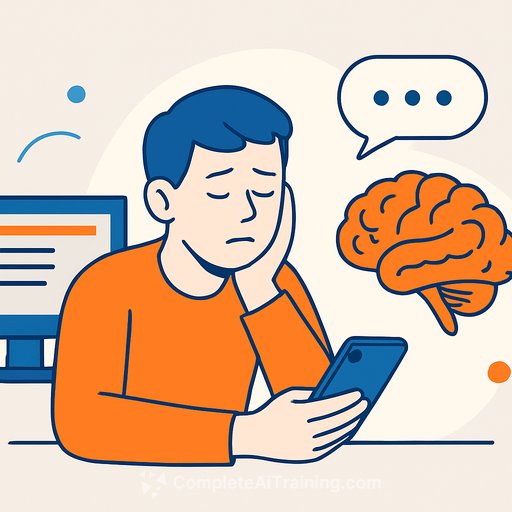The AI Mirage: Is ChatGPT Building Brains or Breaking Them?
Across campuses and classrooms, teachers are seeing a split. AI speeds up output, but there's a growing cost: weaker thinking. Reports in 2025 point to reduced neural engagement when students draft with AI support, signaling shallower memory and reasoning. Many educators feel it every day-polished work, thin understanding.
That gap matters. If students outsource the hard parts, they skip the very struggle that creates skill. The result is neat answers without the mental reps to back them up.
Neural Shadows: What recent research suggests
Studies reported in 2025 describe a pattern: students writing with AI show less activation in planning and memory regions than those working solo. Some researchers called it weakened connectivity-like flipping the brain to "assist mode" too early. It mirrors what faculty share online: students freeze when AI is down, and "bot-to-bot" loops replace real learning.
Translation for educators: the tool isn't neutral. If the student leans on it at the wrong time, the brain does less of the heavy lifting that cements knowledge.
Classroom Realities: What teachers are seeing
Student pushback is growing when courses overly rely on machine-made content. Teachers also report copy-paste essays, rising normalization of AI use at home, and quiet pressure on non-users to "keep up." Reviews in 2025 highlight drops in collaboration and a rise in isolation when AI becomes the default.
- High polish, low transfer: students ace the paper, then can't apply the concept in a new scenario.
- Process avoidance: fewer drafts, less outlining, almost no true revision.
- Over-dependence: panic during outages; "I can't start without ChatGPT."
Ethical Tension: Augment vs. outsource
Across subject areas, performance with AI is uneven and plagiarism concerns remain. University initiatives in 2025 aim to measure retention, transfer, and integrity with real data, not vibes. Reviews recommend the obvious but overlooked stance: use AI as a supplement, not a substitute.
The takeaway for faculty: teach how to use AI without letting it do the thinking students need to own.
The Practical Playbook: Build brains first, then let AI assist
- Process-over-product grading: Require outlines, concept maps, and draft snapshots. Grade the thinking (planning, claims, evidence) as much as the final polish.
- AI disclosure and audit trail: If AI is used, students attach prompts, outputs, edits, and a 5-7 sentence reflection on what they accepted or rejected-and why.
- No-AI zones for core skill reps: Handwritten quickwrites, oral defenses, whiteboard problems, and timed, closed-AI quizzes to build memory and reasoning.
- "Hints, not answers" rule: Students can ask AI for questions, hints, counterarguments, or exemplars-but not final deliverables. The student writes the answer.
- Last 10% policy: AI is allowed for polishing clarity, grammar, and formatting after the student has a full draft and citations.
- Transfer-first assessment: Use open-note tasks that require application to a novel case. AI-trained summaries won't carry them through.
- Oral checkpoints: Random 3-5 minute viva-style check-ins where students explain choices, cite sources, and extend an idea on the spot.
- Spaced retrieval: Short, regular quizzes and cold calls to keep key ideas in active memory.
- Collaboration over copy: Think-Pair-Write, peer review with structured rubrics, and live workshops where drafts change in the room.
- Equity guardrails: Clear AI norms so non-users aren't punished. Provide school-supported tools and training so access isn't the deciding factor.
- Teacher AI rules: Use AI for admin (rubric templates, schedules), not for grading decisions or full lesson content. Human judgment stays in the loop.
- Run small pilots: A/B test AI-optional vs. AI-limited tasks and track retention, transfer, and integrity incidents.
Assignment templates you can use this week
- Process Portfolio Essay: Outline → first draft → peer feedback → revision memo → final. AI allowed only for idea prompts and last 10% polish, with audit trail.
- Case Transfer Task: Teach a concept, then apply it to a novel case in class, offline. Follow with a short oral defense.
- Compare & Edit: Student writes a paragraph, asks AI for a counterargument, then revises. Submission includes both versions and a 6-sentence rationale.
- Concept Map + Mini-Viva: Build a concept map by hand. 3-minute oral walkthrough with two teacher-inserted "what if" questions.
Minimal syllabus policy (copy/paste and adapt)
- AI is a tool, not a substitute for your thinking. Unless stated, AI may be used for brainstorming, outlining, and final polish only.
- You must disclose any AI use and include prompts, outputs, and edits with your work.
- Some tasks are AI-free to build core skills. Using AI when prohibited counts as an integrity violation.
- Be ready to explain and extend your work orally. If you can't explain it, you don't own it.
What to measure this term
- Retention: 1-2 week follow-up quizzes on core ideas.
- Transfer: Novel problem performance, not just re-runs of examples.
- Process quality: Depth of outlines, revisions, and citation accuracy.
- Integrity: Disclosure rates, AI-free violations, and mismatch between written work and oral checks.
- Wellbeing and belonging: Short pulse surveys on workload, confidence, and collaboration.
Guardrails for faculty AI use
- Draft with AI, teach with judgment: let it generate options, but you curate and rewrite for accuracy and fit.
- No AI-only lectures or auto-graded essays without sampling and human review.
- Avoid dependence: keep manual lesson planning reps so your craft doesn't atrophy.
Resources for building AI literacy
If you need ready-made materials and skill paths for educators, explore practical training and curated tools:
Bottom line
AI can speed outcomes, but speed without struggle erodes skill. Your job isn't to block technology; it's to protect the thinking that makes learners independent. Set clear rules, grade the process, and keep human explanation at the center. Build brains first-then let the tools help, on your terms.
Your membership also unlocks:






